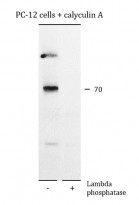ARG40852
anti-DPYSL2 / CRMP2 phospho (Thr555) antibody [M539]
anti-DPYSL2 / CRMP2 phospho (Thr555) antibody [M539] for Western blot and Rat
Overview
| Product Description | Mouse Monoclonal antibody [M539] recognizes DPYSL2 / CRMP2 phospho (Thr555) |
|---|---|
| Tested Reactivity | Rat |
| Predict Reactivity | Hu, Ms |
| Tested Application | WB |
| Host | Mouse |
| Clonality | Monoclonal |
| Clone | M539 |
| Isotype | IgG1 |
| Target Name | DPYSL2 / CRMP2 |
| Antigen Species | Human |
| Immunogen | Phosphospecific peptide (coupled to carrier protein) around Thr555 of Human CRMP2. |
| Conjugation | Un-conjugated |
| Alternate Names | Unc-33-like phosphoprotein 2; Dihydropyrimidinase-related protein 2; Collapsin response mediator protein 2; DRP2; ULIP2; N2A3; DRP-2; DHPRP2; ULIP-2; CRMP-2; CRMP2 |
Application Instructions
| Application Suggestion |
|
||||
|---|---|---|---|---|---|
| Application Note | WB: Antibody is suggested to be diluted in 5% skimmed milk/Tris buffer with 0.04% Tween20 and incubated for 1 hour at room temperature. * The dilutions indicate recommended starting dilutions and the optimal dilutions or concentrations should be determined by the scientist. |
Properties
| Form | Liquid |
|---|---|
| Purification | Affinity purification with immunogen. |
| Buffer | PBS, 0.05% Sodium azide, 50% Glycerol and 1 mg/ml BSA. |
| Preservative | 0.05% Sodium azide |
| Stabilizer | 50% Glycerol and 1 mg/ml BSA |
| Storage Instruction | For continuous use, store undiluted antibody at 2-8°C for up to a week. For long-term storage, aliquot and store at -20°C. Storage in frost free freezers is not recommended. Avoid repeated freeze/thaw cycles. Suggest spin the vial prior to opening. The antibody solution should be gently mixed before use. |
| Note | For laboratory research only, not for drug, diagnostic or other use. |
Bioinformation
| Database Links |
Swiss-port # P47942 Rat Dihydropyrimidinase-related protein 2 |
|---|---|
| Gene Symbol | DPYSL2 |
| Gene Full Name | dihydropyrimidinase-like 2 |
| Background | This gene encodes a member of the collapsin response mediator protein family. Collapsin response mediator proteins form homo- and hetero-tetramers and facilitate neuron guidance, growth and polarity. The encoded protein promotes microtubule assembly and is required for Sema3A-mediated growth cone collapse, and also plays a role in synaptic signaling through interactions with calcium channels. This gene has been implicated in multiple neurological disorders, and hyperphosphorylation of the encoded protein may play a key role in the development of Alzheimer's disease. Alternatively spliced transcript variants encoding multiple isoforms have been observed for this gene. [provided by RefSeq, Sep 2011] |
| Function | Plays a role in neuronal development and polarity, as well as in axon growth and guidance, neuronal growth cone collapse and cell migration. Necessary for signaling by class 3 semaphorins and subsequent remodeling of the cytoskeleton. May play a role in endocytosis. [UniProt] |
| Cellular Localization | Cytoplasm, cytosol. Cytoplasm, cytoskeleton. Membrane. Note=Tightly but non-covalently associated with membranes. [UniProt] |
| Calculated MW | 62 kDa |
| PTM | 3F4, a monoclonal antibody which strongly stains neurofibrillary tangles in Alzheimer disease brains, specifically labels DPYSL2 when phosphorylated on Ser-518, Ser-522 and Thr-509. Phosphorylation at Thr-514 by GSK3B abolishes tubulin-binding leading to destabilization of microtubule assembly in axons and neurodegeneration (By similarity). Phosphorylation by DYRK2 at Ser-522 is required for subsequent phosphorylation by GSK3B. [UniProt] |
Images (1) Click the Picture to Zoom In
-
ARG40852 anti-DPYSL2 / CRMP2 phospho (Thr555) antibody [M539] WB image
Western blot: PC-12 cells stimulated with calyculin A (100 nM) for 30 min. The blots were untreated (left) or treated with lambda phosphatase (right) and stained with ARG40852 anti-DPYSL2 / CRMP2 phospho (Thr555) antibody [M539].






